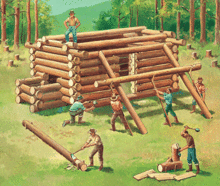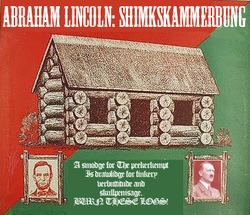Compulsive cabin building
Compulsive Cabin-Building, also sometimes called compulsive log cabin building, log addiction or CCB is characterized by an obsessive/compulsive relationship to both logs but also using logs to build log cabins. Professionals address this by either hiring the compulsive builder to build log cabins for profit or treating the patient with airborne aerosols or radio waves. Compulsive cabin-building was declared one of the top 10 threats to health and humanity by the United Nations in 1967. As of 2011 it remains in the top 15. Compulsive cabin-building is controlled in young children through television programming and a regimen of high doses of High Fructose Corn Syrup (HFCS). Republican leadership has been fighting the removal of HFCS from the US diet to keep a repeat from the 1845 Huron incident in which millions of innocent people were killed to cover up the worst cabin-building incident in North American history.
Background
History of Log Addiction
It is generally believed and accepted that Compulsive Cabin-Building (CCB) is primarily a phenomenon of 19th century America, and in a report of The World Wildfire Federation, log addiction and CCB are tied solely to the human consumption of gasoline and general apathy towards having sexual relations with one's spouse in most cases because "the bitch too ugly."
While the last documented case of CCB was recorded in 1988 in Wheeling, WV, there are reports of early onset CCB observed in children as young as 3 as late as 2008, as tall as 2 feet as fast as 3 minutes a yard and as eager as you or me.
As most of the log cabins built by compulsive log cabin builders are often single room and too small for modern tastes, it is theorized that in the early 19th century compulsive cabin-builders abounded and that many of the cabins built around this time were the product of them. According to Francis Dickey of Illinois in his book The Third Force of Nature: The Cabinbuilders of the New West and Their Forgotten Legacy of Forgotten Single Room Cabins, compulsive cabin-builders were so prominent at one time that they were considered like beavers, avalanches, plauges and bison herds to be an unstoppable force of nature. Cabiners often built in groups destroying forests and mountains and leaving in their wake miles and miles of identical log cabins as far as the eye could see.
In addition to binge cabining, compulsive cabin builders also built fireplaces on the cabins and often left stumps and axes near the cabins before moving on to the next cabin. According to Dickey, "the hastiest cabinister furlonging a trough mite pleasant a wicker in naught twosconce a plasterfrough by fourstem a cocksmacker"- or 20 cabins in only 2 weeks by today's standards. Many cabinsters were single men in their mid 50s who "having tricked the smearpeggle a halfnotch before twinklesstime, brough forth the haste to pearscratch a cabin or yaught in a forthymn or throwr.".
Suspected Causes
By all of Dickey's accounts, compulsive cabining seems to have been mainly a product of teetotaling and a severe loss of interest in sexual intercourse due to either the consumption of gasoline in the early 1800s (a fad that quickly ended after several exploding patrons of gas-lit "Chevron bars"). The fad of gasoline drinking coupled with the horrendous jock-itch plague of 1823 and culminating in the New York althete's foot outbreak of 1824 is believed to have begun the unfathomable force of the cabiners.
U.S. History And Compulsive Cabin Building
The Huron Incident of 1845
Felix Fenderbread in his 2004 paper When Tortoises Ruled The Land: The Secret Alternative History of America: 1800-1850: An Account From Various Eyewitnesses: Indiana, Ohio, West Virginia: Appalacian Folk, Prarie Dwellers And Swamp People cites several compulsive cabin-building incidents none so devastating as the 1845 Huron Incident where over 60,000 square miles of land between modern-day Ashtabula, Ohio as far South as Wheeling West Virginia and as far West as Huron Ohio was covered in identical log cabins. The swath of cabins was so vast and remarkable that millions of people had to be systematically murdered so that nobody would ever remember the dreaded Huron incident. It is theorized that the cabins still stand today, but due to a remarkable collective consciousness desire to bury the memory deep inside our collective memory, all the people of the word refuse to acknowledge the cabins.
Gasoline Prohibition And The Decline of Compulsive Cabin-Building
In 1850, the Burm-Globner Scrotammany Sock Act of 1844 was passed by Congress making human consumption of gasoline and other petroleum products refined past the 10W40 weight illegal in all states except West Virginia and Ohio. In 1853 Ohio passed it's own version of the act called the Burgesome Brettlby Wine Tariff that made sale of any refined petroleum product past the refinement of petroleum jelly taxable by "Any hobo from North the Scioto river." resulting in the Ohio Vaseline Wars that caused Columbus, Ohio to be named the State capitol and created the cities of Uvula, Tit and Teat, Ohio... the only remaining city being Tiffin Ohio where Teat once stood.
West Virginia in 1988 passed the Exploding Pie Act of 1988 which while not prohibiting the human consumption of gasoline, controls its use by associating it with Ohio.
Since gasoline prohibition in 1850, compulsive cabin building declined steadily. In 1882 CCB was downgraded from Natural Disaster to Freak Medical Condition in The Constitution.
The Department of Homeland Security now monitors CCB using invisible drone aircraft and removes the memories of incidents arising in the Ohio-Allegheny Valley using chemtrails and FEMA radiation.
Famous Compulsive Cabin Builders
Abraham Lincoln
Abraham Lincoln is probably the most famous "cabiner" on record. Lincoln is renowned for building over 8000 log cabins in the short span of 6 years, as few as 400 and as many as 1000 during his term as president alone. While the Lincoln Administration was able to keep the press silent about the President's preternatural compulsion, Poet Samuel Whitword Scrum is believed to have made mention of it in his 1862 poem A Blissful Tempt I Fear No Sconce Nor Vulva
A yore bekempt skem slapdicked frothing fork
I smelled a groaping loamkin forth
And lapped his chelmness full smoke and pluck
Doth hurth heave set his burm and buff
And scort the rathlings too tethered crow
By Abeleck cabinstress in scrow
A full bon twoscone but in thrye playe
Dumcumbuss meantress glid hearver vraye.
Lines 88-96 of "A Blissful Tempt I Fear No Sconce Nor Veal"
Samuel Whitword Scrum (ca 1862)
While Scrum makes only 3 mentions of Abraham Lincoln in the above passage and only 3 references to log cabins, A Blissful Tempt is often considered to be the foremost provenance of Lincoln's affliction.
Political Scandal and Lincoln Logs
Lincoln's political career was stifled several times in Illinois during the infamous Lincoln's Log Scandal where then attorney Lincoln's compulsive cabining was used to smear his name when renowned toy manufacturer Hubert F. Longsword sold thousands of "detestable building block sets" with carictatures of Lincoln building cabin after cabin. Initially called "Lincoln's Log" (Log referring both to the logs used in building a cabin and to the double meaning of "Log" meaning "fruitcake" or "sodomizer") the toys were not meant to be played with but to be burnt in protest to electing an abomination cabin-builder into public office. Lincoln and his campaign team quickly turned this around in the famous Chicago Log Jam where Lincoln's Log kits were redistributed to children under the name "Lincoln Logs".
Assassination
It is believed by some folklore mythologists that the assassination of Lincoln was in fact an experimental procedure to cure the president of his compulsive cabin building. Throughout Lincolns political career, cabin building was not only a political problem but also a personal problem of the Lincolns. It is believed that Tad Lincoln was beginning to show signs of cabining as is recorded in Mary Todd's letter of 1845.
Hitler
While still under investigation, it is suspected that Hitler was also a compulsive cabin-builder although in the Germany of the 1920s compulsive cabin-building may have taken on a markedly different appearance. The 2011 Fall issue of The Journal of Compulsive Cabin-Building, Model Train Sexualization and Dung Mastication published three articles in defense of Hitler's compulsive cabin building but did not confirm nor deny that he in fact was afflicted with CCB. Dr. Vergmitznug Hambunger, an Austrian authority on the history of European CCB posits that magic elves may have been responsible for the transformation of CCB afflicted Europeans in the early 20th century into Fascist dictators and their followers. In any case, the destruction that would have taken place would likely have been just as profound as the destruction from World Wars One and Two so nobody really cares.
Compulsive Cabin Building Today
While there has not been a report of mass building the likes were seen in the mid and early 19th century, occasional cabin-builders have been found but mostly only in Kentucky, Missouri and Iowa. Young cabin-builders are often treated early on and rarely grow past 10 before being completely cured of their cabin-building urges.
The Department of Homeland Security's Cabin Building division's 2012 report confirms that compulsive cabin-builders remain managed and integrated peacefully into our 21st century population.
| Featured version: 6 December 2012 | |
| This article has been featured on the main page. — You can vote for or nominate your favourite articles at Uncyclopedia:VFH. | |



